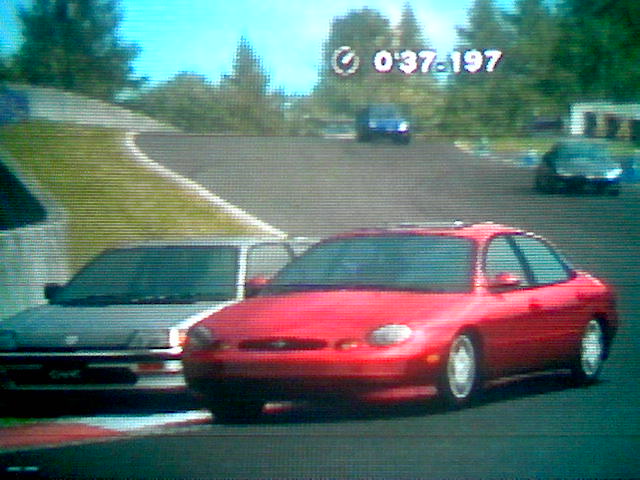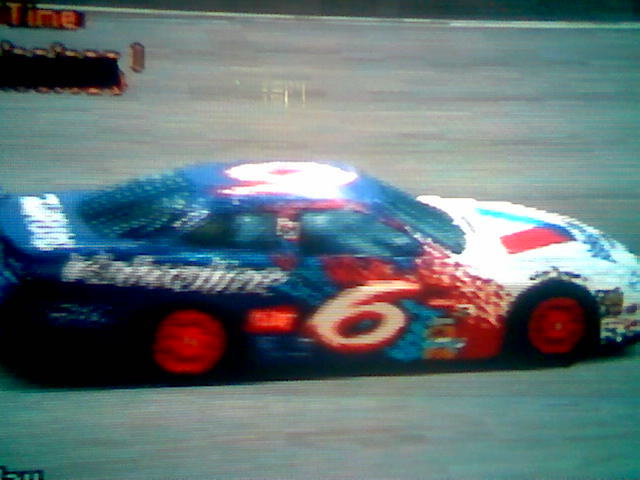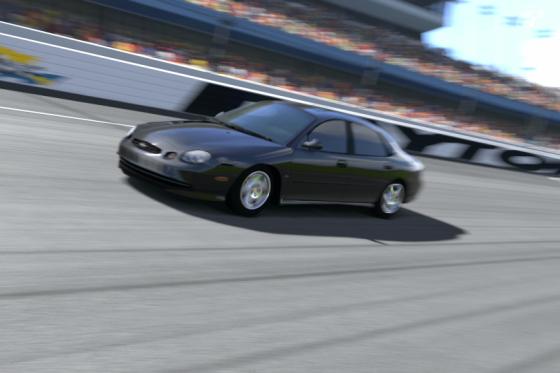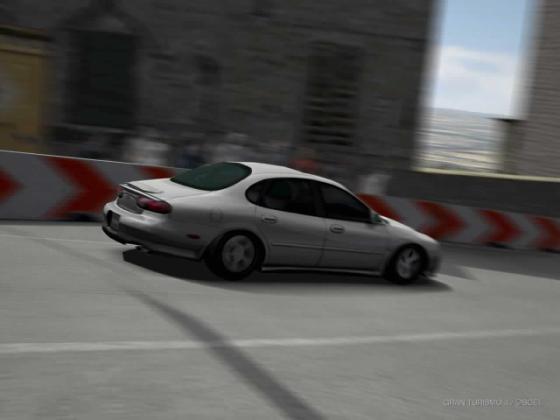|
Years Represented: 1998-1999
Host: GT2, GT4, & GT5
Class: Mid-size
Type: Sedan
Country: United States
Price: $30,980 (GT2) // $13,755 (GT4 UCL) //
$23,643 (GT5 UCL)
GT5 mileage as tested: 17,570.6
Length: 198.4" // Width: 73.0" // Height: 55.8"
Wheebase:
108.5"
Overhang: 7 feet 6 inches
TracK 61.6" [F] 61.4" [R]
Ground Clearance: 6.1"
Construction: unit steel
Weight;
3,326 pounds
Wgt. Dist: 66/34
Steering: power-assist rack & pinion
Turns Lock to Lock: 2.66
Layout: Front
Engine / Front Drive
Tires: P225/55ZR-16
F. Suspension: MacPherson struts, coils, lwr. control arms, anti-roll bar
R.
Suspension: Quadralink, coils, anti-roll bar
Brakes: vented discs [F], solid discs [R]
Engine: 207
cubic inch DOHC V8
Construction:
Aspiration: natural
Fuel System: sequential port fuel injection
Valves
/ Cyl: 4
Bore x Stroke: 3.24" x 3.13"
Compression: 10.0:1
*GT4 Taurus was given oil change
*GT5 Taurus
was given oil change but no engine rebuild
Final BHP
GT2: 235 @ 5,800 rpms
GT4: 234 @ 6,100
GT5: 233 @ 6,000
Final Torque:
GT2: 230 @ 5,000 rpms
GT4: 230 @ 4,800
GT5: 228 @ 5,000
Credits per HP:
GT2: $131.83
GT4: $56.78
GT5: 101.47
Pounds per HP:
GT2: 14.2x
GT4: 14.21
GT5: 14.27
Hp
per Liter:
GT2: 69.3
GT4: 69.0
GT5: 68.7
Idle Speed (GT4): 1,000 rpms
Idle
Speed (GT5): 750 rpm
GT2 Redline: 6,750 // RPM Limit: 7,000
GT4 Redline: 7,000 // RPM Limit: 7,500
GT5
Redline: 7,000 // RPM Limit:
Trnasmission: 4-speed automatic
0-60 mph:
GT2: 7.0 seconds
GT4: 8.633
GT5: 7.833
0-100mph:
GT2: 17.7 seconds
GT4: 18.416
GT5: 18.330
400 M:
GT2: 15.278 @ 92 mph
GT4: 16.461 @ 92 mph
1 Kilometer:
GT2: 27.491
@ 125 mph
GT4: 28.676 @ 124 mph
Test
Track:
GT2: 1:47.491
GT4: 2:31.054
GT5: 1:01.450 (Daytona)
100 to Zero mph: 6.14 seconds (GT4)
Top Gear RPM @ 60 mph:
2,000
GT2 Top Speed at Redline:
1st: 42 mph
2nd: 78 mph
3rd: 120 mph
4th: 157.70 mph
@ 6,100 rpms
GT4 Top Speed at Redline:
1st: 49 mph
2nd: 91 mph
3rd: 142 mph
4th:
158.00 mph @ 5,500 rpms
GT5 Top Speed at Redline:
1st: 47 mph
2nd: 88 mph
3rd: 138 mph
4th: 149.xx mph @
5,200 rpm

--------------------EXTERIOR / HISTORY------------------
Anyone hungry for some bread and butter? In the mid-'80s, Ford provided
their Taurus--one of the most famous "bread & butter" automobiles of all-time. Affordable to the middle-class, thrifty
at the gas pumps, practical in many ways, and ready for sales to millions of customers. Let's find out why this was so important.
In
the early '80s, things looked grim for many American automakers. Sales were way down, mostly because our cars sucked.
American Motors and Chrysler in particular looked as though they were going to die within a matter of weeks. GM
and Ford were suffering too, but weren't doing as bad. After half a decade of false starts (like the Chevy Citation,
Oldsmobile Omega, American Motors Eagle, and Chrysler's K-cars), America was finally getting the hang of mass-producing
some things worthwhile. Ford's trump card was the Taurus. In many ways, the Taurus is one of the main keys that saved
Ford from bankruptcy.
Arguably, the Taurus became the "Model T" of the '80s and '90s, since many millions of copies
were mass-produced. It was a rather plain and simple car...inoffensive, mostly dependable, and therefore became
easily popular. The Taurus was the first of several cars to feature Ford's new "jelly bean" shape. This
slightly goofy, roundish look provided both functional and developmental features. The jelly-bean got away
from Ford's previously blocky-looking '70s cars like the Fairmont and LTD, while also providing better aerodynamics and
(therefore) fuel-efficiency. Things were looking up for FoMoCo. To celebrate, Ford began taking a few risks, which is how
the first SHO (Super High Output) version of the Taurus came about in 1989.
The SHO has quite an interesting history.
Little did I know that the original small-block 3.0 liter V6 engine, for instance, was actually a Yamaha
powerplant (Yamaha makes automotive engines too? I did not know that) that was produced for the 2-seat, mid-engine Pontiac
Fiero. Now let's think about that for a minute. The Fiero was America's only mass-produced mid-engine car of
the '80s, and it had a 4-cylinder motor. So Pontiac was also about to take some risks too, by putting a V6 in their baby.
Unfortunately,
none of this ever happened. The Fiero vanished towards the end of the '80s, and Ford somehow picked up the contract from
Yamaha/GM. Oddly, they decided to use these engines (rather than their own). The Taurus SHO was meant to be
sold for just one year (1989) just like the Buick GNX, but customer demand changed all that, since 15,000
were produced and sold with ease. So Ford decided to keep the SHO around. For 10 years (and three generations),
it was a strong seller just like their ordinary bread & butter Tauruses. Finally in 1999, sales declined
to just 3,000, and the SHO followed the Fiero towards automotive heaven.
As a cousin of regular Tauruses, the
SHO resembles these everyday drivers, but sports a slightly more aggressive look. Small side skirts, a small air dam
up front, a tiny wing on the trunk, as well as dual-exhausts are sported on the SHO in our games. Perhaps SHO customers
were typically dads who needed a sedan, yet didn't want to be seen as "ordinary". The SHO appears in three
Gran Turismo games: GT2, GT4, and GT5. In the 2nd game (GT2), the SHO was still a new model in real-life, but in GT4, it can
now be found only in the used lot. Hence, its price has dropped drastically from $30,000 to just $13,000. GT5 wants more from
us, I found a used model with 17,570 miles on it costing $23,643.
At 3,326 pounds, it is heavy
for a front-drive. In GT2, the SHO can be race-modified, at the least it will weigh 2,841 pounds. GT4,
on the other hand, boasts some mad weight reductions...Stage 1 removes an amazing 401 pounds! Stages
2 and 3 remove about 100 and 66 pounds respectively, for a total loss of 567 pounds in this game...a minimum
of 2,759 pounds at the least. Isn't that cool? 2,759 pounds is still heavyish for a front-drive, but at least
there is some power to be had, as we'll see. GT5 (which features glass replacement) drops us all the way to 2,704.
For
those of you who have the glitchy GT2 version 1.0, when you race-mod, what you'll get is Mark Martin's Valvoline NASCAR
Taurus! The sucky thing is, the car remains front-drive; which is unrealistic since all NASCAR machines are
rear-drive. Despite this, it does get alot of power, as we'll see in the next section. Oddly, in versions 1.1 and
1.2, Mark Martin's Taurus is now gone; instead, there's a generic racing kit.
I'm not sure why this is,
and to this day I've never been able to find a straight answer, even at wikipedia. My guess: Mark Martin's camp had some
sort of deal with Polyphony Digital and/or Sony, which was half-baked when GT2 was first released in North America (December,
1999). Upon release, perhaps things seemed unsatisfactory, probably because of money issues, so Mr. Martin or his organization
could have threatened to sue. To prevent this, PD pulled the famous Valvoline Taurus.
Well, in our
game, the Taurus SHO has both some merits and some detriments. Let's explore one of its merits first.


--------------ENGINE / DRIVETRAIN-------------
As mentioned, the V6 engine in original Tauruses was a Yamaha powerplant,
but this changed. Eventually, Ford stepped up to a V8, which had a Cosworth-designed block; but which still used Yamaha heads. The
earliest SHOs had manual transmissions only. Many Americans complained about this, so for the 2nd generation Ford
introduced an automatic as well. Finally, by the time the 3rd generation was released, Ford dropped the manual (probly it
wasn't selling), and all 3rd-gen machines are automatics; hence, I used an auto for all my track tests and driving.
Those
of you who have GT2 know there are several front-drive American cars that didn't make it to GT4. The Dodge Neon coupe (rather
than the sedan in GT4 & 5), Mercury Cougar, and Dodge Intrepid are some examples. Both the Intrepid and Cougar wind
up being the strongest front-drive cars in the game, with somewhere over 500 horses for each.
Here, the
SHO gets left behind. It can be tweaked with two stages of natural tuning, and at best boasts "just" 364 horsepower
in GT2, even tho it's supposed to have some NASCAR heritage. Truthfully, the V8s used in NASCAR Tauruses were larger than
the one in the civilian version. So (to go off-topic for a moment) why can an Intrepid accept NASCAR-level power even
though its engine is of similar size to the SHO? Hmmm...
In GT4, things are looking up. We can equip a 3rd NA tune
in this game, for a grand total of 400 bhp @ 6,100 rpms and 367 foot-pounds @ 4,800 rpms. This
is good. This allows us to finish many races in this game, including the FF Challenge (obviously), Clubman Cup, NA Challenge,
Hot Rod Competition, Stars & Stripes, and even some Special Condition events. It has to power to do more, but can't due
to its front-drive layout, which eventually becomes a burden as rear and all-wheel drives start to dominate the further we
go.
GT5 allows three NA tunes and no supercharger. We've got (again) some nice jumps in horsepower from one kit to
the next for a front-drive, and overall 5 takes us a little further than GT4 did, with 410 hp @ 6,800 rpm
and 349 foot-pounds at 5,900.
The transmission now. The SHO starts with a 4-speed that
is tall, and at times feels clunky to use when combined with front drive and V8 power. Amazingly, I have used this box occasionally
for racing (like during the Pro-level Muscle Car Championship in GT5), and I can report that this incredibly tall unit
actually does have some usefulness here and there. But generally this set of gears is bad for racing. 1st gear
comes into play more often than it seems it should during super-slow corner areas; thankfully wheelspin is only common if
the car is not on sport tires, yet. In 2nd, 3rd, and 4th gear, the engine (grunty as it is) now has quite a burden to
fulfill.
The good news is: close gearing and super-close gearing can be used at smaller tracks, which
means a splurge on full-custom gears isn't always necessary. In GT2, both devices are 5-speeds, but GT4 & 5's super-close units
are 6-speeds. No matter which transmission in which game we have, power gets doled out fairly because peak
HP is always several hundred rpms below redline (assuming tuning hasn't been performed in some cases).
When power
is low, the front-end surprisingly can handle the V8's torque. I was expecting a lot more torque-steer early on, especially
in GT4 and 5. I was expecting this car to be worse than the PT Cruiser, and thought I'd need a limited-slip even before Stage
1 power was bolted in, but was wrong. Go figure. Even pushing over 300 hp and beyond, this one can handle the tension. As
far as I know, the Taurus SHO did not use a limited-slip device straight from the factory, so it must be doing something else
right.
--------------CHASSIS / HANDLING----------------

As I drove a Taurus SHO for the first time, I had a few fantasies going. Upgraded Tauruses
are used as intermediate police vehicles in America, you see. Occasionally a Taurus can be found on COPS! or some other reality
TV crime show, and they seem to do pretty good with speeds of 70...80...90 mph and beyond in the hands of a cop driver. But
in the game? How does the SHO compare?
...The thing is, I can't help but compare the
SHO to the PT Cruiser, since both are American, both have torquey engines, and both are front-drive. But in many ways,
the SHO is simply superior.
To simulate cars in their natural state, I always drive them stock with normal
tires in GT2, but N2 or N3 tires in GT4. The SHO of GT5 has soft comfort tires stock, so this is what I used in this game. So
as I drove the SHO around Laguna Seca (GT4 and GT5), everything I expected was here. TONS of understeer on entry,
for instance...early braking doesn't help unless you start really early, and even then it can still show up. Wheelspin
galore can also be a problem at times (especially assuming power has been upgraded beyond Stage 1). And in general, trying
to steer precisely under power just plain sucks in a Taurus! This is not an Integra or a Peugeot 106, both which can
be driven on crappy tires with relative success.
Things change once the SHO has sports tires. A lot of those previous
issues become diminished. We no longer have to brake entirely in a straight line for instance, now we can now mildly
trail-brake. The Taurus still understeers in any game on occasion, but overall things improve for the better. This
is the car I envision a cop driving.
On COPS!, the police who drive Tauruses often have to wrestle their cars as they're
chasing some "bad boys", but these Taureses generally don't just seem as if they're about to understeer off into the
grass at every turn like the cars I just drove on cheap tires.
And here's where I like
to compare the SHO to the PT.....
1). The PT requires at least a 1-way differential once power is mildly tweaked.
The SHO does not.
2). Wheelspin out of corners is loud and fun in a PT with this mild power..in the SHO, wheelspin
shows up at times, yet is tamer. Wheelspin and smokey tires are rare while the engine's power is non-modified.
3).
The PT suffers from body-sway, which can swing the car around with unexpected oversteer, especially at tight esses
and corners. The SHO (with its lower center of gravity) feels more solid, more controllable in these same situations.
But
the Taurus SHO still has plenty of issues. It is nowhere near the top of the front-drive kingdom, especially
since it's a 16 and a half foot-long car with 4 doors in a land where many front-drives are smaller 3-door hatches and
2-door coupes. On the other hand, the SHO does offer a few surprises here and there. Not all of these surprises
are calamitous.
PROS-----------------------------------------
1). That
gutsy V8 engine. It's a micro-block...not some giant, heavy V8 as found in many other Americans. It's got some gusto, too.
2). Front-end traction is good while power is low, if you drive with care.
3). Two NA upgrades in GT2. Three
in GT4 or 5. Power isn't the greatest in either game, but at least you'll be able to surpass many other typical front-drives
4).
Good power delivery since peak HP is located safely below the redline. Automatic tranny users can eke all they can with this
layout. Most racing will not require a full-custom transmission.
5). Weight can be removed...lots of it in any game.
In GT2, cars can be race-modified. If you have version 1.0, you'll actually get Mark Martin's famous Valvoline Taurus!
6).
Nicely priced in GT4 under $15,000, since the Taurus SHO is a used car. It is often easy to find, too; one doesn't have to
wait weeks to months just to get an SHO in the garage.
7). Near-160 mph stock! Acceptable acceleration for a front-drive.
CONS-----------------------------------------
1). The understeer
we expect. It's not the absolute worst of any GT game, but it's up there.
2). As power gets upgraded,
that safe traction mentioned in the Pros section eventually gives way to hoards of torque-steer. This generally kills the
SHO's steering, too.
3). Many front-drives have good braking action, especially in racing situations. Not the SHO.
4).
In GT2, the Taurus remains somewhat heavy with a racing kit at 2,841 pounds.
5). Body-sway and oversteerish behavior
aren't common till power gets upgraded, and you're tackling some more technical courses. Or trying to. Somewhat less clumsy
than a PT Cruiser--which ain't saying much.
6). The SHO in GT2, at $30,000+, is rather pricey for a clumsy, heavy front-drive
sedan. Oddly, it lowered in price during GT4's day, yet can now be found (again) for around $30,000 in GT5.
7). Generally
not a very fun car to pilot around. Not like a lighter front-drive can be. Kicking down the throttle and listening to that
wheelspin is a blast, but not "safe" during actual racing situations.
8). Eventually you will need some top-quality
parts. Full-action limited-slip being at the top of the list.
9). The first-gen SHO from 1989 had a boss look to it.
In comparison, the 3rd-gen from our game doesn't look much different from an ordinary Taurus. Some may find its "plain Jane",
everyman's-car, jellybean looks ugly or worse.
Published: September 18, 2008
(here's to you, Jimi)
GT5 info added sometime in 2011.
|



